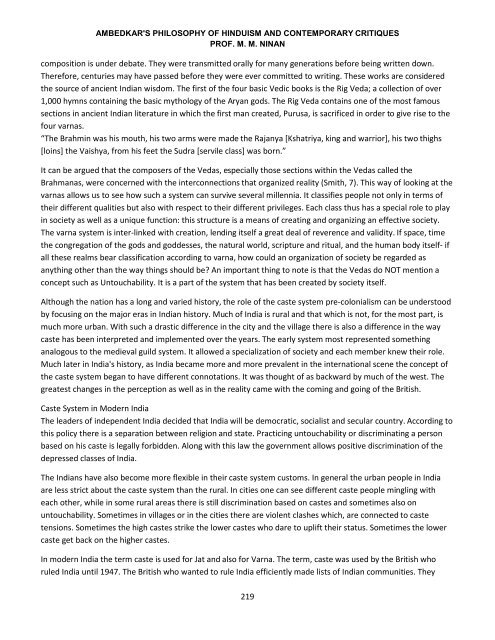Ambedkar-Philosophy of Hinduism
You also want an ePaper? Increase the reach of your titles
YUMPU automatically turns print PDFs into web optimized ePapers that Google loves.
AMBEDKAR'S PHILOSOPHY OF HINDUISM AND CONTEMPORARY CRITIQUES<br />
PROF. M. M. NINAN<br />
composition is under debate. They were transmitted orally for many generations before being written down.<br />
Therefore, centuries may have passed before they were ever committed to writing. These works are considered<br />
the source <strong>of</strong> ancient Indian wisdom. The first <strong>of</strong> the four basic Vedic books is the Rig Veda; a collection <strong>of</strong> over<br />
1,000 hymns containing the basic mythology <strong>of</strong> the Aryan gods. The Rig Veda contains one <strong>of</strong> the most famous<br />
sections in ancient Indian literature in which the first man created, Purusa, is sacrificed in order to give rise to the<br />
four varnas.<br />
“The Brahmin was his mouth, his two arms were made the Rajanya [Kshatriya, king and warrior], his two thighs<br />
[loins] the Vaishya, from his feet the Sudra [servile class] was born.”<br />
It can be argued that the composers <strong>of</strong> the Vedas, especially those sections within the Vedas called the<br />
Brahmanas, were concerned with the interconnections that organized reality (Smith, 7). This way <strong>of</strong> looking at the<br />
varnas allows us to see how such a system can survive several millennia. It classifies people not only in terms <strong>of</strong><br />
their different qualities but also with respect to their different privileges. Each class thus has a special role to play<br />
in society as well as a unique function: this structure is a means <strong>of</strong> creating and organizing an effective society.<br />
The varna system is inter-linked with creation, lending itself a great deal <strong>of</strong> reverence and validity. If space, time<br />
the congregation <strong>of</strong> the gods and goddesses, the natural world, scripture and ritual, and the human body itself- if<br />
all these realms bear classification according to varna, how could an organization <strong>of</strong> society be regarded as<br />
anything other than the way things should be? An important thing to note is that the Vedas do NOT mention a<br />
concept such as Untouchability. It is a part <strong>of</strong> the system that has been created by society itself.<br />
Although the nation has a long and varied history, the role <strong>of</strong> the caste system pre-colonialism can be understood<br />
by focusing on the major eras in Indian history. Much <strong>of</strong> India is rural and that which is not, for the most part, is<br />
much more urban. With such a drastic difference in the city and the village there is also a difference in the way<br />
caste has been interpreted and implemented over the years. The early system most represented something<br />
analogous to the medieval guild system. It allowed a specialization <strong>of</strong> society and each member knew their role.<br />
Much later in India's history, as India became more and more prevalent in the international scene the concept <strong>of</strong><br />
the caste system began to have different connotations. It was thought <strong>of</strong> as backward by much <strong>of</strong> the west. The<br />
greatest changes in the perception as well as in the reality came with the coming and going <strong>of</strong> the British.<br />
Caste System in Modern India<br />
The leaders <strong>of</strong> independent India decided that India will be democratic, socialist and secular country. According to<br />
this policy there is a separation between religion and state. Practicing untouchability or discriminating a person<br />
based on his caste is legally forbidden. Along with this law the government allows positive discrimination <strong>of</strong> the<br />
depressed classes <strong>of</strong> India.<br />
The Indians have also become more flexible in their caste system customs. In general the urban people in India<br />
are less strict about the caste system than the rural. In cities one can see different caste people mingling with<br />
each other, while in some rural areas there is still discrimination based on castes and sometimes also on<br />
untouchability. Sometimes in villages or in the cities there are violent clashes which, are connected to caste<br />
tensions. Sometimes the high castes strike the lower castes who dare to uplift their status. Sometimes the lower<br />
caste get back on the higher castes.<br />
In modern India the term caste is used for Jat and also for Varna. The term, caste was used by the British who<br />
ruled India until 1947. The British who wanted to rule India efficiently made lists <strong>of</strong> Indian communities. They<br />
219


















